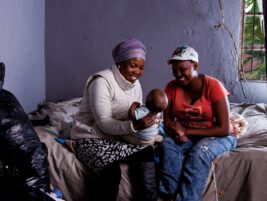Background
The awareness of Infant and Early Childhood Mental Health (IECMH) as a field has increased in recent years (e.g., Clinton et al., 2016). Yet, too frequently, young children’s needs are not identified until after the optimal time for early intervention has passed. Up to 20% of U.S. children (<5 years) experience social-emotional problems that negatively affect functioning, development, and school readiness (Brauner & Stephens, 2006). IECMH problems can significantly impact parental mental health, which can, in turn, affect parent-child interactions and contribute to further social-emotional concerns (Bernard-Bonnin et al., 2004). Left untreated, early social-emotional and/or parent-child interaction concerns can lead to behavioral, emotional, and pre-academic concerns that persist into adulthood. Thus, early intervention in IECMH is critical to positive short- and long-term physical and mental health outcomes for children with developmental or social-emotional delays and for parent-child dyads that exhibit relationship challenges (Karoly, et al., 2005; Ramey & Ramey, 2004). Interventions with young children also present opportunities to assess and support the entire family system. These early interventions are important to longer-term outcomes for individual children and families, yet 70% or more of children who experience developmental disabilities and mental health concerns are not identified until school entry, by which point many opportunities for effective intervention have been missed (Glascoe, 2005).
Well-child visits in pediatric primary care are a natural and relatively unexplored opportunity to prevent, identify and treat, or refer children with IECMH concerns. It is estimated that over 90% of children in the United States regularly visit a pediatric primary care provider (PCP) (NCQA, 2022). Moreover, most children under five receive care from a PCP prior to school enrollment (NCQA, 2022), which makes well-visits a natural entry point for increasing access and reducing barriers (e.g., stigma) to mental healthcare. The American Academies of Pediatrics and Family Physicians guidelines recommend screening for social-emotional concerns beginning in infancy. Despite these recommendations, consistent and effective screening, particularly for social-emotional development, remains variable (Wissow et al., 2013). Additionally, detection rates can be low, as medical providers may not be trained to utilize screening results and/or to identify mental health concerns (Wissow et al., 2013). Unfortunately, PCPs often lack in-depth training and knowledge to assess and intervene in IECMH concerns, despite their interest in doing so (Olson et al., 2002; Horwitz et al., 2007).
Despite the importance of early identification and access to mental health care, few pediatric primary care have access to experts in social-emotional problems within their settings who could otherwise enhance PCPs’ IECMH expertise, provide resources for supporting IECMH, and/or address implementation barriers/facilitators. While some training programs require behavioral health education across the lifespan as part of their core curriculum (e.g., Baird et al., 2017), this is not true of all primary care disciplines. To enhance access to care for at-risk children and families, several models of integrated behavioral health (IBH) programs have been developed (e.g., Healthy Steps; Briggs et al., 2014). However, these programs are often costly and require hiring additional staff, which may make them inaccessible to smaller clinics/systems. Programs may also be variable with some more focused on clinical care than PCP education or vice versa. Given the breadth of information that must be covered in primary care training, even programs which provide PCP education around IECMH may be under-resourced. Thus, opportunities exist to deepen and broaden existing curricula. Further, few programs work across disciplines (e.g., family medicine, pediatrics, nursing) to simultaneously train learners on topics related to IECMH.
The current manuscript presents a model utilizing an interprofessional team developed to support the education of PCPs (residents, learners, and faculty) in multiple primary care settings. Specifically, providers in pediatrics, family medicine, nursing, psychiatry, and psychology built a pilot system for children’s mental health consultation within primary care settings. The history of the current program, model details, and case examples will illustrate the potential impact of this approach as an intervention in children’s mental health and the implications it has for IECMH specifically. Modifications to the model during the COVID-19 pandemic and lessons learned will also be discussed to inform others who may seek to implement or fund similar programs.
Project History
Prior to the current project, several children’s mental health education opportunities existed for primary care providers, residents, and nurse practitioner learners in the team’s system. For instance, pediatrics residents had a psychiatry consultation-liaison service available for inpatient units and could discuss cases with the child psychiatrist on call. Additionally, monthly mental health cross-disciplinary case conferences were available to pediatric residents (Collaborative Office Rounds; Sajady et al., 2019) and family medicine residents (Interprofessional Team Meetings). Preceptors (i.e., faculty) and residents brought challenging cases to discuss and to receive suggestions from attendees regarding diagnosis, assessment, intervention, and referrals; in some but not all programs, these meetings were led by a behavioral health director. Not all providers were in the presenting role at every case conference, so the opportunity to receive case-specific feedback was often limited. Additionally, when discussions were after the fact, and/or limited by time, ‘real world’ practice opportunities were not as robust/available.
Clinical content related to mental health was also integrated into didactics within resident and nurse practitioner education programs via academic half-day blocks. The depth of content varied by program and was often curtailed by limited time and/or the specific expertise of available faculty. Some sites also had integrated behavioral health services, but this was not consistently available across disciplines. Additionally, “hands-on” practice opportunities with real, nuanced patients were limited because of the didactic context. To expand children’s mental health education during training and to work across disciplines, the current project sought to build a sustainable model for educational consultation in IECMH for PCPs.
Project Model
The project has two core content features: educational training and case-based educational consultations. The consultations build on real-time learning moments, in-depth discussion of cases, and discussion/demonstration of IECMH intervention and caregiver interview techniques. The focus of these consultations is two-pronged: children’s mental health content and how best to support parents and caregivers in these efforts. Essential to this model is its interprofessional design. At the outset, the project team intentionally sought faculty from Pediatrics, Family Medicine, and Nursing to ensure utility across fields. Consultants involved in direct education for residents and trainees also represent multiple disciplines (i.e., psychology and psychiatry) to encourage multiple angles of discussion. Additionally, the project team integrated a sustainable, capacity-building mindset from the start so that the model would ultimately be viable in the long-term.
Educational Consultations
Consultants from psychology and psychiatry disciplines are engaged with learners (and faculty supervisors) in their primary care continuity clinics five half-days per week. Initially, the model was designed as on-site consultation, but due to the COVID-19 pandemic, virtual options were created as well. During pandemic surge periods, the virtual consultation room was used when in-person visits were limited. The virtual ‘room’ ultimately became an opportunity for serving multiple sites simultaneously, even as pandemic restrictions eased, and in-person consultation resumed.
Consultants review clinic schedules to identify patients that may have mental health questions and can access medical charts to guide both teaching points and clinical recommendations. Consultants model history-gathering (e.g., performing trauma or mood disorder screens), treatment planning (e.g., explaining different therapy modalities and stepwise medication adjustments), and psychoeducation (e.g., teaching about common behavioral concerns by developmental stage). In these conversations, tips are provided for building relationships with parents and caregivers in order to partner with them in addressing children’s mental health needs.
Educational Training for Residents, Nurse Practitioner (NP) Learners and Faculty
Consultants develop a monthly newsletter called ‘Pediatric Pearls for Children’s Mental Health’ (Pearls) which are distributed in hard copy at the clinics involved in the project and via email to each training program. In total there are more than 50 NP learners, 25 family medicine residents, and 115 pediatric residents. Over 50 faculty preceptors also receive these Pearls. In each issue, suggestions are given for identifying a concern, proactively addressing the topic within a visit, guidelines for discussing concerns (e.g., questions to ask families), and additional resources (e.g., articles, books, podcasts, online videos, and social media accounts). The topics are determined based on questions that arise during consultations and are tailored to be timely based on seasonal or societal circumstances. For example, in November, when vaccines became available for children aged five to eleven years, the topic was focused on anxiety. The newsletter also included suggestions to address vaccine anxiety, as younger children became eligible for the COVID-19 vaccine. In December, the Pearls included discussion of holiday celebrations, routines during school breaks, and supporting families through uncertain times. January, a month when COVID-19 began another surge, focused on building resilience in both children and providers.
Consultants also created “smartphrases” which can be typed into the medical records system and provide populated resources for commonly asked questions/concerns. These smartphrases are commonly used within the healthcare system and are designed to assist in tailoring commonly placed referrals such as therapy, psychiatry, or case management for a specific patient. In this case, project smartphrases allow for a provider to type in a short phrase like “IECMH transitions” to bring up tips and tricks for easing transitions with young children.
Additional (iterative) tools
This project is designed to be iterative in nature, which has proven to be especially important during recent years. Additional tools and adjustments are regularly implemented to enhance the effectiveness of consultation. For instance, when virtual consultation uptake lagged, reminders were developed for faculty supervisors and clinic huddles. Additionally, a flier with a QR code was created and circulated digitally and placed in clinics to remind providers of the service. The flier also links to a calendar that lists consultant availability and coverage if a consultant is out of the office. In turn, the availability of live updates allows for morning huddle reminders to providers regarding which consultants are available that day. Smartphrases, described above, were also created as a point of care reference for PCPs to remind them how to access the virtual consult room or route consultation questions via the electronic health record if they did not have time to discuss the case during a busy clinic morning or afternoon.
In the next section, case examples are presented to illustrate the impact of pediatric mental health educational training and consultation work in a busy residency clinic.
Brief Case Examples
Case 1: “Xavier” was a 2½-year-old boy whose parents had felt his behavior was appropriate and easily managed, until the birth of their second child. Once his sibling was born, Xavier became aggressive toward his parents and began having disruptive tantrums. Xavier’s parents raised these concerns during a well-visit. The mental health consultant reviewed the nature of the tantrums and provided psychoeducation regarding typical toddler responses to large life changes. They also discussed tracking and assessing new toddler behavior problems over time as possible markers of developmental delays or unrecognized medical problems, versus a response to a stressor. In this case, the tantrums appeared to be closely linked to the new sibling and no regressions were noted in other areas of development. The consultant and learner discussed topics for parental psychoeducation and reviewed behavioral interventions to share with parents. This included scheduling “special time” for Xavier to spend with each parent focused on 1:1 play to decrease jealousy, reading about a new sibling to normalize the experience and allow expression of feelings, and providing labeled praise and positive reinforcement for desired behaviors (e.g., interacting appropriately with the baby). Ultimately, Xavier and his parents benefitted from this brief consultation by both providing interventions for currently concerning behavior and preventing longer-term concerns from developing.
Case 2: “Gabe” was a three-year-old boy who presented for a telehealth visit with pediatric resident “Jamie.” Gabe’s parents raised questions regarding sensory concerns and increasingly aggressive behaviors that were causing problems at home and school. Jamie shared this case with the mental health consultant and described several symptoms that sounded consistent with an autism spectrum disorder. The consultant helped Jamie formulate follow-up questions designed to clarify the symptoms and their onset as well as to plan for the next steps. Jamie and the consultant agreed that an in-person follow-up visit would be important to conceptualizing the concerns and making appropriate referrals. A week later, Gabe and his parents arrived at the clinic. Initially, Jamie was confused about what should happen in this follow-up visit, given that a preliminary referral had already been placed for parent-child therapy. The consultant reviewed with Jamie observations that might help inform the current questions. Jamie learned behaviors and interactions to look for in the clinic room between Gabe and his parents, as well as small interactions she could try herself with Gabe (e.g., pointing, engaging in conversation/play to gauge reciprocity). During the visit, Gabe’s parents also noted that he had more limited interactions with other children due to the COVID-19 pandemic extending over his early years. Jamie returned from the visit to review the case with the consultant and her faculty supervisor, who also gleaned suggestions for evaluations of autism symptoms. The interactions that Jamie shared appeared to be inconsistent with autism. The team also reviewed the COVID-19 pandemic context and its impacts on early social-emotional development. Based on this experience, Jamie better understood the importance of in-person follow-up as well as the impacts of the pandemic and characteristics that might be present in a young child with autism.
Case 3: “Maddie” was a 12-year-old with a history of ADHD and early life trauma while in her birth mother’s care. She and her adoptive mother presented to the clinic to see “Jill,” a pediatric resident, just prior to a scheduled trip to visit her birth mother. After returning home from past visits, Maddie has struggled with emotional dysregulation and aggression to the point that crisis services and use of the emergency room have been required. With hopes to prevent similar episodes this time, they requested medication that could be used to calm Maddie for the week after her trip. Jill discussed this case with the behavioral health consultant who was able to shift the frame of Maddie’s case from a purely behavioral lens requiring psychopharmacologic treatment to one that may be seen through a developmental lens with consideration for how Maddie’s early life trauma and attachment were contributing to her clinical picture. The consultation also included discussion of the impact of COVID-19 restrictions that led to reduced predictability of visits. These lenses expanded Jill’s understanding of Maddie’s behavioral outbursts as well as the scope of treatment. Instead of focusing only on medications, treatment was broadened to include strategies such as increased therapy sessions pre/post-trip, mindfulness, and self-identified coping strategies such as exercise, yoga, and journaling to prepare for her trip, process intense experiences during the trip, and proactively prepare for the return home. While medications were included in the treatment plan, they were an adjunct to the plan, if needed, rather than the primary component.
Lessons Learned
Throughout this project, the team has learned several lessons, and incorporated changes through an iterative process. One challenge was helping residents find time for consultation within a busy clinic day. This was particularly relevant when only virtual consultation was offered (opportunities and challenges of the virtual modality are discussed further below). An initial observation was that of the “spillover effect”; once a given learner or faculty engaged in a consultation, they tended to consult again on future cases, which increased utilization. The team also found that combining informal consultation with formal didactics and organized meetings increased impact. For example, topics raised in lectures led to follow-up questions in clinic, or conversations about patient cases generated new ideas for lecture content. In addition, consultants began joining complex case team meetings. The presence of the consultants at these regular targeted meetings resolved the time pressure barrier and created another opportunity to build relationships and familiarity with the consultation team, which contributed to additional consultations down the road.
As discussed above, the COVID-19 pandemic prompted the introduction of a virtual modality for consultation. The virtual consultation experience afforded many opportunities to expand reach and flexibility, while also creating some challenges. The main advantage to virtual consultation is the ability to reach multiple clinics with a variety of learners simultaneously — particularly for a large metropolitan area with widely dispersed clinical sites. Virtual consultation also increased opportunities for interprofessional learning because trainees from across programs (family medicine, pediatrics, nursing) were able to join the same consultation session and share (de-identified) cases. Finally, it became easier for consultants to review charts of scheduled patients quickly and ahead of time, providing further mechanisms for consultation (i.e., direct messages to providers prior to consultation time).
The virtual room also presented challenges. Initially, and particularly on busy days for residents, consultants could be “out of sight, out of mind”; it was easy to overlook the access to a consultant when mental health may not have been top of mind, and other visits were pressing the afternoon forward. Additionally, if technological barriers were encountered, residents were more likely to abandon the attempt at consultation rather than wait and have to prolong their patient’s visit. Whereas, in person, residents were more likely to circle back later in the day and persist in their efforts to connect with a consultant. Additionally, when in person, consultants were easily able to join spontaneous conversations about behavioral health concerns, and this became difficult when consultation was virtual. Although the virtual room allowed consultants to “listen in” on preceptors reviewing cases, it was hard to pick out opportunities to engage residents in conversations about mental health without the social cues of the in-person setting. Some preceptors also felt uncomfortable with a consultant continuously listening in virtually, so they would mute the sound on the clinic end. Finally, it became difficult to model discussions with caregivers and demonstrate techniques that could have otherwise been used in the moment. Once in-person consultation was again feasible, and residents and faculty were familiar with engaging the consultant, it was easier to have an occasional virtual day when needed. Going forward, it will be important to determine how best (and how much) to keep virtual options available, particularly when considering expansion to more sites.
Conclusion
As the gap continues to widen between increased need for children’s mental health services and limited availability of practitioners, it is essential to expand IECMH education for pediatric primary care providers. Providers have a great deal of interest in this area, as families increasingly use primary care visits to raise questions about emotional and behavioral functioning. This is increasingly essential and an even more frequent need, as the COVID-19 pandemic continues to impact child development and well-being. Well-child visits offer an important opportunity for assessment, early intervention and prevention, as well as continuity of care for young children and their families, for whom the primary care clinic is a consistent point of contact and source of advice. Ultimately, by building IECMH skills in primary care providers, child and family mental health will be positively impacted at a larger scale.
References
Baird, M., Hepworth, J., Myerholtz, L., Reitz, R. & Danner, C. (2017) Fifty Years of Contributions of Behavioral Science in Family Medicine. Family Medicine, 49(4): 297-304.
Bernard-Bonnin, A-C., Canadian Paediatric Society, Mental Health and Developmental Disabilities Committee (2004). Maternal depression and child development. Paediatrics & Child Health, 9(8), 575–583. https://doi.org/10.1093/pch/9.8.575
Brauner, C. B., & Stephens, C. B. (2006). Estimating the prevalence of early childhood serious emotional/behavioral disorders: challenges and recommendations. Public Health Reports, 303-310.
Briggs, R. D., Silver, E. J., Krug, L. M., Mason, Z. S., Schrag, R. D. A., Chinitz, S., & Racine, A. D. (2014). Healthy Steps as a moderator: the impact of maternal trauma on child social-emotional development. Clin Pract Pediatr Psychol, 2(2), 166-175. 10.1037/cpp0000060
Clinton, J., Feller, A. F., & Williams, R. C. (2016). The importance of infant mental health. Paediatrics & child health, 21(5), 239–241. https://doi.org/10.1093/pch/21.5.239
Glascoe, F. P. (2005). Screening for developmental and behavioral problems. Mental Retardation and Developmental Disabilities Research Reviews, 11(3), 173-179.
Horwitz S. M., Kelleher K. J., Stein R. E., Storfer-Isser, A., Youngstrom, E. A., Park, E. R., et al. (2007). Barriers to the identification and management of psychosocial issues in children and maternal depression. Pediatrics, 119(1), e208-e218. Doi: 10.1542/peds.2005-1997.
Karoly, L. A., Kilburn, M. R., and Cannon, J. S. (2005). Early Childhood Interventions: Proven Results, Future Promise. Santa Monica, CA: RAND.
National Center for Quality Assurance (NCQA; 2022). Children and Adolescents’ Access to Primary Care Practitioners. HEDIS Measures and Technical Resources. Retrieved from: https://www.ncqa.org/hedis/measures/children-and-adolescents-access-to-primary-care-practitioners-cap/
Olson, A. L., Kemper, K. J., Kelleher, K. J., Hammond, C. S., Zuckerman, B. S., & Dietrich, A. J. (2002). Primary care pediatricians’ roles and perceived responsibilities in the identification and management of maternal depression. Pediatrics, 110, 1169-76.
Ramey, C., & Ramey, S. (2004). Early Learning and School Readiness: Can Early Intervention Make a Difference? Merrill-Palmer Quarterly, 50(4), 471-491.
Sajady, M., Borman-Shoap, E., Murray, K. E., Homans, J., Barnes, A. J. (2019). How to strengthen PCPs’ mental health training. Contemporary Pediatrics, 36(11). https://www.contemporarypediatrics.com/view/how-strengthen-pcps-mental-health-training
Wissow, L. S., Brown, J., Fothergill, K. E., Gadomski, A., Hacker, K., Salmon, P., & Zelkowitz, R. (2013). Universal mental health screening in pediatric primary care: A systematic review. J Am Acad Child Adolesc Psychiatry, 52(11):1134-1147. doi: 10.1016/j.jaac.2013.08.013.
Authors
Lingras, Katherine A.,
Department of Psychiatry and Behavioral Sciences, University of Minnesota Medical School, Minneapolis, MN, USA
Schlesinger, Amanda,
Department of Psychiatry and Behavioral Sciences, University of Minnesota Medical School, Minneapolis, MN, USA
Danner, Christine,
Department of Family Medicine, University of Minnesota Medical School, Minneapolis, MN, USA
Berge, Jerica M.,
Department of Family Medicine, University of Minnesota Medical School, Minneapolis, MN, USA
Borman-Shoap, Emily,
Department of Pediatrics, University of Minnesota Medical School, Minneapolis, MN, USA
Friedrich, Cheri,
Department of Nursing, University of Minnesota Medical School, Minneapolis, MN, USA
Benbenek, Mary,
Department of Nursing, University of Minnesota Medical School, Minneapolis, MN, USA
Barnes, Andrew J.,
Department of Pediatrics, University of Minnesota Medical School, Minneapolis, MN, USA
Cullen, Kathryn R.,
Department of Psychiatry and Behavioral Sciences, University of Minnesota Medical School, Minneapolis, MN, USA
Balder, Hannah,
Department of Nursing, University of Minnesota Medical School, Minneapolis, MN, USA
Alquist, Greta,
Department of Psychiatry and Behavioral Sciences, University of Minnesota Medical School, Minneapolis, MN, USA
Steingraeber, Catherine J.,
Department of Psychiatry and Behavioral Sciences, University of Minnesota Medical School, Minneapolis, MN, USA
Corresponding Author Contact Information:
Katherine A. Lingras
Masonic Institute for the Developing Brain
2025 East River Parkway
Minneapolis, MN 55414
Email: klingras@umn.edu
The authors note no conflicts of interest, human subjects approvals, or funding relevant to this manuscript.








